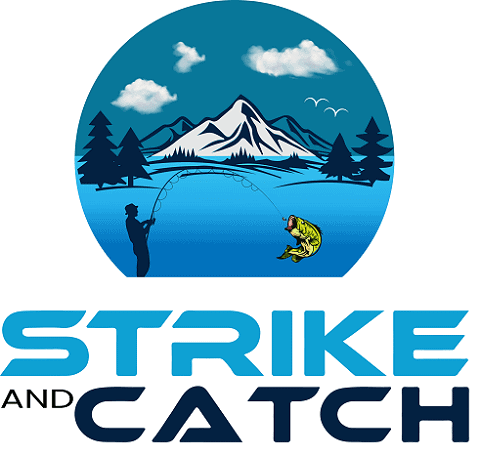The different salmon species are an extremely interesting topic that fascinates people from around the world.
Most of them are aware of the fact that there are both Pacific and Atlantic salmon out there, but not many people know what the differences between those two major salmonids are. That’s why I decided to write this article.
Atlantic and Pacific salmon belong to the same family of fish but have different genera, making them separate species. While the Pacific chinook salmon is bigger than the Atlantic salmon, it is the wild Atlantic salmon that tends to taste better than the Pacific salmon types.
If you want to get more facts and information on the much-discussed topic of Atlantic vs. Pacific salmon, all you have to do is keep reading.
Are Atlantic Salmon the Same as Pacific Salmon?
It is not merely the different names that set Atlantics and Pacifics apart from each other.
While both the Atlantic salmon and all the five major Pacific salmon types are distantly related and share the same family of fish (Salmonidae), they have a different amount of chromosomes and completely different genera.
Atlantics belong to the genus Salmo salar, while the Pacific salmon genus is called Oncorhynchus.
They are hence two different salmonid species that, as their names so aptly suggest, originate from and dwell in two different oceans.
It is that natural difference in habitat that has made them evolve into the different salmon types of today.
And that doesn’t really come as a surprise at all, given that a research paper from 2012 has suggested that there are even chromosomal differences between European and North American Atlantic salmon.
So, wild Atlantics belong to the Atlantic Ocean, and Pacifics, you guessed it, belong to the Pacific Ocean.
That’s why you can only find Atlantic salmon along the US and Canadian east coast and in its tributaries, while Pacific salmon can only be found on the US and Canadian west coast and in its tributaries.
That also means that there are Atlantic salmon on the European side of the Atlantic. Pacific salmon, on the other hand, can be found on the Asian side of the Pacific Ocean.
What Are the Different Salmon Types?
While Atlantic salmon only include one species (Salmo salar), Pacific salmon include a total of five species:
| King or chinook salmon (Oncorhynchus tshawytscha) |
| Coho salmon (Oncorhynchus kisutch) |
| Chum salmon (Oncorhynchus keta) |
| Pink salmon (Oncorhynchus gorbuscha) |
| Sockeye salmon (Oncorhynchus nerka) |
RELATED ARTICLE: If you want to read up on all of the different types of salmon, you should definitely check out this in-depth guide on salmon species that I wrote a while back!
Do Pacific and Atlantic Salmon Look the Same?
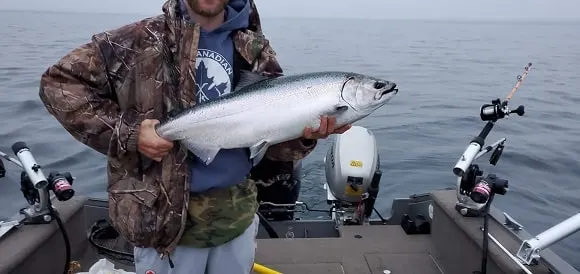
As long as they dwell in saltwater or in the depths of the Great Lakes, Atlantic and Pacific salmon look quite alike, as they are all of bright, silvery color.
Once they enter freshwater, however, all salmon types undergo significant physiological changes, making them look very different from each other.
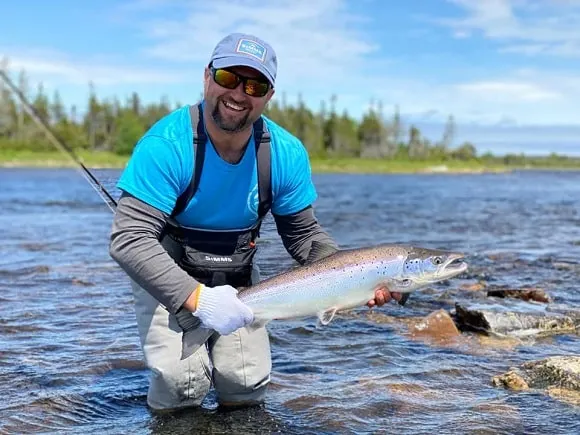
(courtesy of Jamie Hughes)
While keeping their brightly silver-colored bodies at the very beginning of their freshwater journey toward their natal spawning grounds upstream, they soon start to become darker and darker, switching to a brown, red, green, or sometimes even blackish color.
It is during this stage of their lives that it is the easiest to visually tell the different salmon species apart from each other.
The body coloration is entirely dependent on the salmon type, as well as on the turbidity, depth, and light intensity underwater; the darker and deeper the river, the darker the salmon will turn.
Apart from changing body colorations, the males of most salmon species also developed humped backs, enlarged teeth, and hooked lower jaws (this is also called the kype).
Here are a few examples of how Pacific and Atlantic salmon can look when dwelling in freshwater:
King Salmon
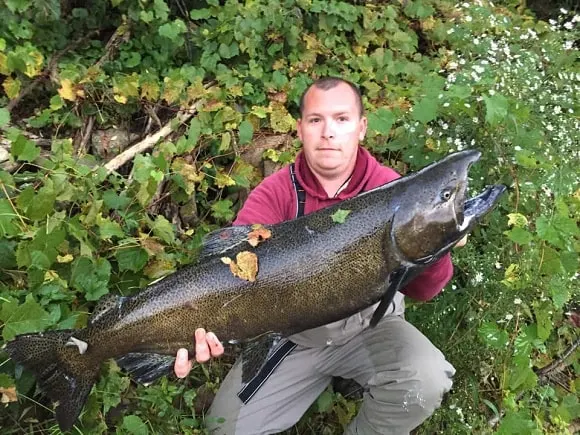
Atlantic Salmon
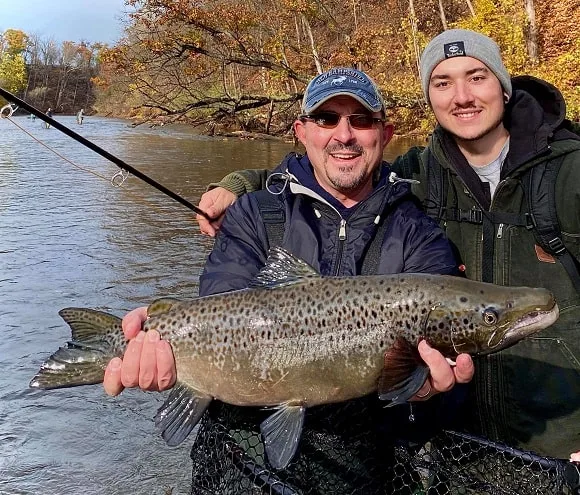
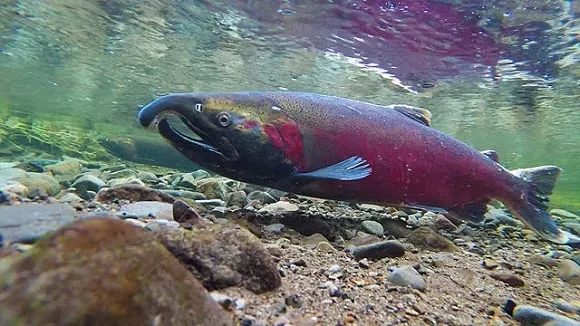
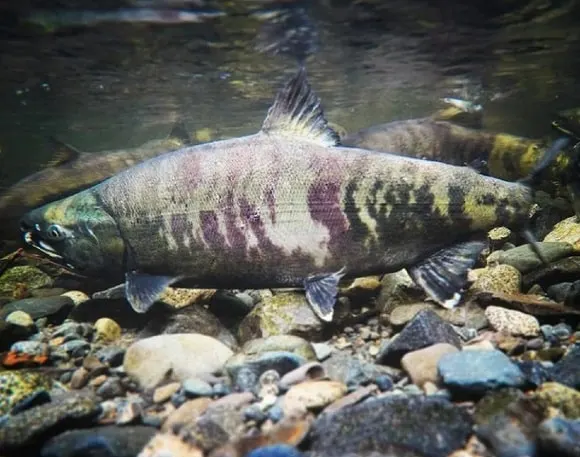
Courtesy of Chris Walling (find his pics on Instagram: @steel_snorkel)
Sockeye Salmon
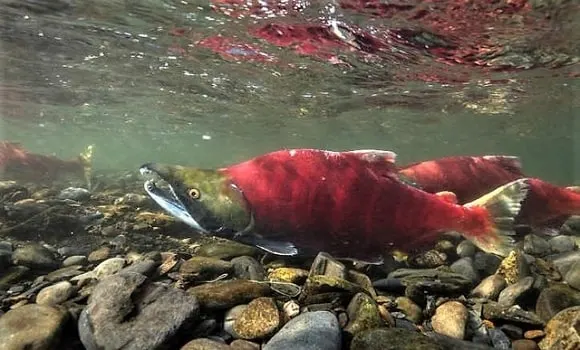
Pink Salmon
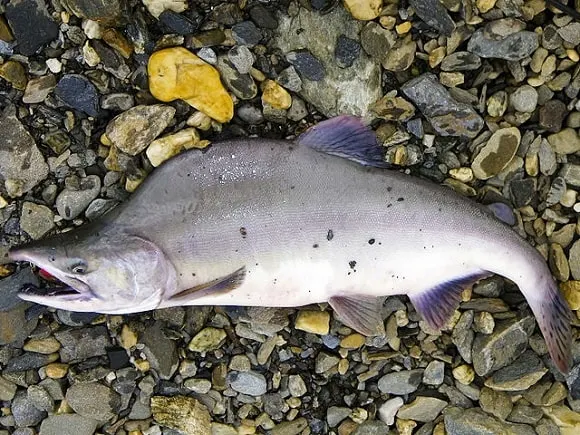
(by Bering Land Bridge National Preserve – Pink Salmon, CC BY 2.0)
Are Pacific Salmon Bigger than Atlantic Salmon?
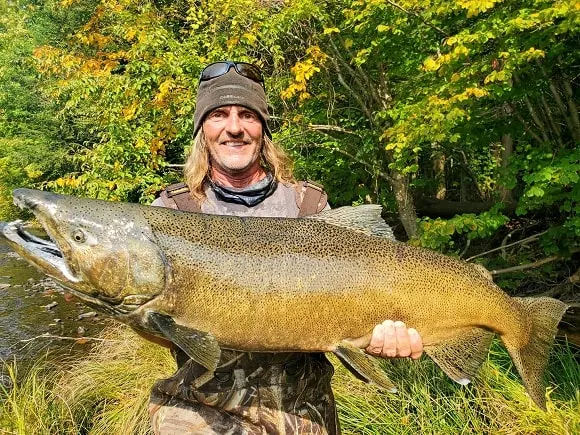
The Pacific king (chinook) salmon is bigger than all the other Pacific salmon types and the Atlantic salmon. But it’s a pretty close call, as the Atlantic is not far behind!
The biggest king or chinook salmon ever caught was a gigantic fish of 97lb 4oz. The biggest king salmon ever recorded, however, was even bigger! That fish had an incredible weight of 126lb.
And to be completely honest with you, the vast coastal regions of North America must hold even bigger chinooks than that. I am fairly certain of it!
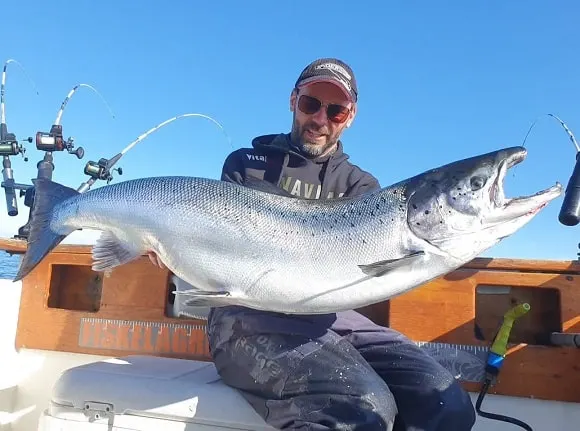
For comparison, the biggest rod-caught Atlantic salmon was a fish of 79lb 2oz. The biggest ever recorded Atlantic was a fish of 103lb.
No matter what type is the bigger one, both of these salmon can grow to reach prodigious sizes, and I can’t even start to imagine what a 70 or 90+pounder must feel like on the rod. What unbelievable catches they must have been!
RELATED ARTICLE: What Are Landlocked Salmon? (Interesting Fish Facts)
Can Atlantic and Pacific Salmon Be Found in the Same Body of Water?
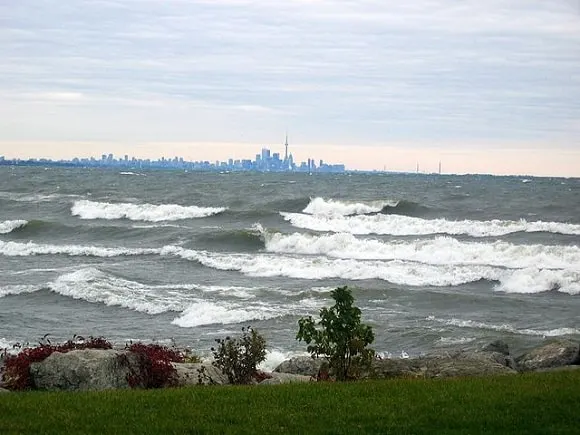
While wild Pacific and Atlantic salmon can’t be found in the same waters, stocked and/or landlocked fish can definitely do so.
The most popular example of a body of water that contains both Atlantic and Pacific types of salmon is the Great Lakes in North America.
Most notably, it is Lake Ontario that contains both Atlantic, chinook, and coho salmon.
As a matter of fact, Lake Ontario once held the biggest population of landlocked Atlantic salmon in the world, which is a historical fact that not many people know about.
In the 19th century, the fish suddenly vanished and were absent from the lake for many decades.
Fairly recently, however, thanks to huge population restoration efforts, the Atlantics have made their way back to Lake Ontario and are now, once again, considered an established species in the lake and its tributaries.
Chinook and coho salmon, on the other hand, have only been in Lake Ontario for the past 50 years or so and are still being stocked annually to this day.
This shows that both Atlantics and Pacifics can co-exist in one and the same freshwater system.
Can Pacific and Atlantic Salmon Crossbreed?
As Atlantic salmon and all of the Pacific salmon have different numbers of chromosomes and do not share the same type of genus, they are not able to interbreed and create offspring.
Besides, the wild populations of the Pacific and the Atlantic could never reach each other, even if they were able to crossbreed.
Additionally, neither the landlocked salmon of e.g. the Great Lakes nor the often escaping farmed Atlantic salmon are capable of interbreeding with other types of salmon.
Although, it has been observed that the latter have managed to crossbreed with brown trout.
Do Atlantic Salmon Taste Better Than Pacific Salmon?
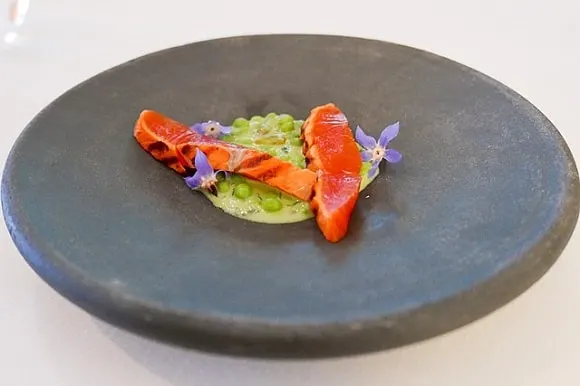
This is a much-debated question that obviously depends on personal taste, as well as the habitat the fish are found in.
And while most people eat and enjoy Atlantic salmon, the salmon type that is generally considered the tastiest one is the Pacific sockeye salmon.
The reason why most people eat Atlantic salmon is fairly simple: farmed Atlantic salmon is the most commonly sold salmon in both supermarkets and restaurants around the world. It’s simply a question of supply.
But the people who’ve eaten both farmed and wild salmon will usually agree that wild salmon taste a lot better than farmed ones.
And among those wild-caught salmon, the sockeye really stands out, both when it comes to taste and texture.
Sockeyes that have been caught in saltwater are especially delicious, as the saltwater further enriches the meat’s taste and makes it firm-textured.
Sockeye also have a lower fat content than other salmon species, which is an appreciated fact by many gourmets.
RELATED ARTICLE: Everything You Need to Know About Commercial Salmon Fishing in Alaska
What Type of Salmon Is Used for Sushi?
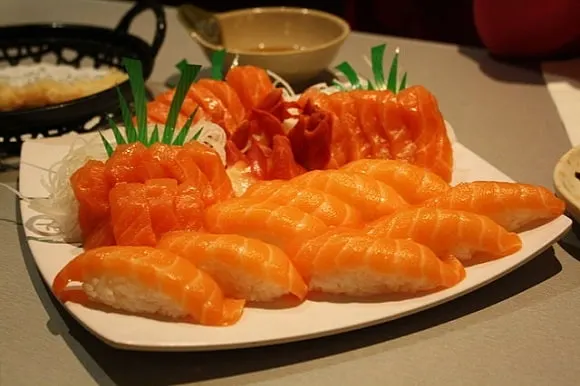
In North American and Japanese restaurants, both chinook, chum, and sockeye salmon are commonly used for making sushi.
Most restaurants in Europe will only use farmed Atlantic salmon for their sushi.
Naturally, both the American and Japanese markets have a great supply of Pacific salmon, which is why they have the luxury of using them over farmed Atlantics, which simply do not have the same quality of meat or taste to them.
As I live in Scandinavia, the fact that we can only eat farmed salmon when eating sushi is really unfortunate, as I love sushi and would like to try the “real deal” one day!
When it comes to making your own sushi at home, you should, however, only use farmed Atlantic or farmed Alaskan salmon, as the risk for parasites in raw Pacific salmon fish is simply too high.
Which Salmon Has Least Mercury?
Whether we’re talking salt or freshwater, nearly all fish on earth contain traces mercury. Some areas and stocks contain more, others less.
Salmon are fairly low in saturated fats, meaning they generally don’t contain high amounts of mercury.
Still, if you want to avoid eating foods that contain mercury (e.g. during pregnancy), you should stick to the following types of salmon:
- wild Alaskan Pacific salmon
- farmed organic Atlantic salmon
Various studies show that these salmon types contain the lowest amounts of mercury.
What Salmon Has the Least Fat?
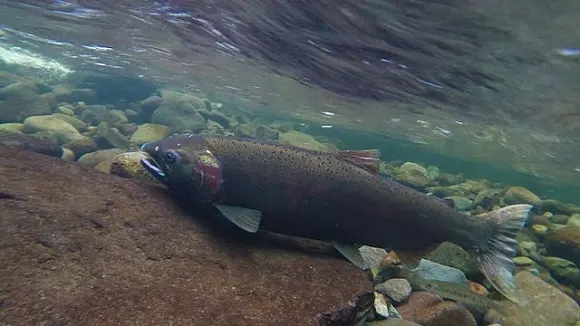
Coho and pink salmon are the two types of salmon with the lowest fat content.
Thanks to that, these salmon species have a lighter but also less salmon-like taste.
For that reason, most people prefer the fishier and richer taste of sockeye or king salmon, which also happen to contain more fat.
What Is the Unhealthiest Salmon?
Mass-produced, farmed Atlantic salmon are generally considered to be the least healthy.
For one thing, farmed salmon often contain a lot more fat than regular salmon, and consuming them can contribute to diabetes, heart disease, and obesity.
For another, studies have shown that farmed Atlantic salmon often contain high amounts of toxins and even pesticides.
For these reasons, it has been many years since I have eaten Norwegian salmon!
Wild-caught Atlantic or Pacific salmon are generally the much healthier food choice for you.
Is Norwegian Salmon Pacific or Atlantic?
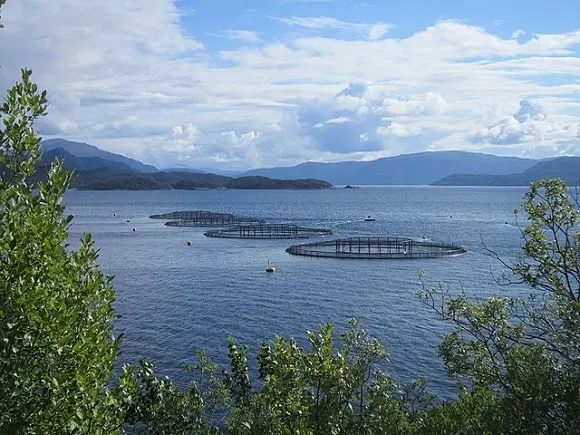
All Norwegian salmon you can find in your local food store are Atlantic salmon.
The fact that Norway only has a Northeastern Atlantic coastline makes access to the Pacific salmon types an impossibility in Scandinavia.
Related Articles
- Why Do Salmon Die After Spawning?
- Everything on Salmon Teeth (Interesting Fish Facts)
- When Do Salmon Spawn?
Featured image courtesy of Jamie Hughes and Jim Coyle
